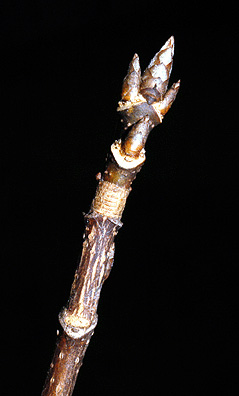
Remember MADCapHorse? Maple lateral buds, leaf scars and twigs are all oppositely arranged. Sugar maple twigs are brown, slender and shiny with very sharp terminal buds.

Catalpa twigs are not oppositely or alternately arranged - they show a whorled arrangement. There are three leaf scars and buds at each node! Leaf scars are where the leaves used to be attached. Catalpa has obvious crater-like leaf scars.

Oaks have multiple end buds. White oak twigs are red-brown to somewhat gray, hairless, shiny/waxy, with rounded and hairless buds.

Black locust has obvious paired spines, which are modified leaves. The twigs are angular, zig-zag and red-brown to gray in color.

Ginkgo, apples, and cherry trees have obvious spur shoots. These shoots usually bear flowers/fruit and only grow a few millimeters each year.

Winged elm twigs are slender, hairless, slightly zigzag, reddish-brown, with red-brown buds. Twigs have conspicuous corky wings that protrude one-half inch.

Walnut twigs are very stout, have leaf scars that resemble monkey faces, pale buds, and a very distinctive chambered pith.

Yellow-poplar buds have only two bud scales - they are valvate. Another interesting feature of yellow-poplar twigs are the stipule scars that surround the twigs. Stipules are modified leaves.

Some twigs are covered with obvious hairs. Staghorn sumac is a good example of this.